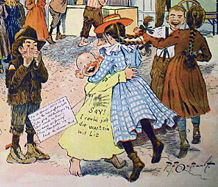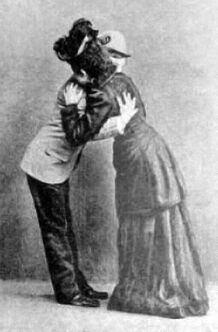Spiel
The spiel (pronounced shpẽl or spẽl) was a street dance from late 19th and early 20th century New York City, which originated from the working class culture of the Lower East Side and the Bowery. It was mainly performed by young women and children and became popular in the 1880s. The spiel was usually danced to music of the street organ in an uptempo triple meter, similar to the more formal European waltz, and its style was generally described as frenetic, twirling and ecstatic. The term spiel was later also applied to other dances.
Etymology and meanings of spiel
Until the 1880s a vibrant German culture had developed in New York. The verb "to spiel", originally from German spielen ("to play", "to perform"),[2] was at first used to denote the playing of circus music (spieling),[3] often performed on organs. The barrel organ of the hurdy-gurdy man accompanying the original street dance may have attracted the earlier circensial term, or spiel was based on the imperative Spiel! of German immigrants ordering the organist to play his instrument. It eventually entered the vernacular of the streets and dance halls of the East side and the Bowery, at first with spieler as the general term for "dancer".[4] The terms spiel or spieling[5] were soon applied as a pars pro toto for the sidewalk and dance-hall spiels as well as later dances like the tough dance (v.i.). In a more specific sense, the spielers of the early 20th century were the female dancers of the dance halls and saloons, while their male partners were called toughs. It has been assumed that a spieler, when generally interpreted as "player", connoted a flirtatious and often promiscuous character,[6] which is definitely implied by the later meaning of the word, which by the 1920s denoted males hired by dance-hall owners to entertain and dance with women who attended without a partner.[7]
The original sidewalk spiel
The sidewalk spiel was mostly danced by young girls and children. Not unlike the victims of the legendary German pied piper, the children would gather behind the hurdy-gurdy man and follow him from block to block, sometimes dancing an often frenzied spiel for several hours.[9] The rhythmic dances of the girls were a "familiar thing to see […] on the East Side" and became a prominent part of New York folklore.[10] Apparently only one testimony by former spieler Marie Jastrow has survived, which describes the movements of the sidewalk spiel around the year 1900:
[…] foolish, little tripping dances, they were. First on one leg, twirling the other one around and around to the rhythm of the music. Then, a change to the other leg, when the whole process was repeated.[11]
The drawing by G.A. Davis (see above) clearly shows the tripping on one leg and the twirling movements of the young spielers, with couples in a close waltz posture in the background. James W. Blake's lyrics of New York's unofficial song of the time, The Sidewalks of New York, alluded to the sidewalk spiel by referencing the waltzing, twirling, stepping and tripping dance of boys and girls to organ music on the city streets.[12]
It is unclear whether the contemporary observers and authors, who generally considered the spiel to be a provocation, referred only to the dance-hall spiel (see below) or also to the children's and young women's street dance. The sidewalk spiel might have served their personal amusement, or they might have hoped to earn small donations from the crowd. Ellery Foutch theorized that the sidewalk spiel perhaps foreshadowed the career of the spieling prostitute and noted that "the dance and [the dancers'] posture would have resonated with contemporary viewers as rebellious, sexually provocative activity".[13]
Dance-hall spiel
Dances like the spiel functioned as a means and symbol of liberation. Like feminism, which was at first a movement of the petite bourgeoisie, the dances originated from the working-class and helped the women overcome Victorian social constraints, which emancipated them earlier than women of the middle- and upper-class.[15]
MORE…
The dance-hall spiel usually paired female and male partners, whereas the former was often swung high off the floor. Hutchins Hapgood commented on the dance-hall variant, which quickly developed from the sidewalk spiel:[16]
The dance-hall is truly a passion with working-girls. The desire to waltz is bred in the feminine bone. […] Some of them dance every night, and are so confirmed in it that they are technically known as "spielers".[17]
The culture of the dance-hall spiel was mentioned in many contemporary songs, e.g. The Spielers by J. L. Feeney[18] or in a popular waltz song of 1894:[19]
My Pearl is a Bowery Girl[20]
She's all the world to me.
She's in it with any the girls 'round the town,
And a corking good looker, see?
At Walhalla Hall she kills them all
As waltzing together we twirl.
She sets them all crazy, a spieler, a daisy,
My Pearl's a Bowery girl.
Tough dance
LATER.
Spiel's end
The girl dancers of the sidewalk spiel remained "an enduring folkloric image of New York from the 1880s to around 1910", depicted e.g. on paintings by George Luks and Jerome Myers[22] and referenced in other works of art, e.g. in cartoons (v.s.). The street dance of the children and young working women vanished quickly, when street organs and street pianos became frowned upon and their owners debarred during the time of the First World War,[23] whereas the dance-hall spiel had already been gradually replaced by more favored styles like the tough dance (see above).[24]
Notes
- ↑ Children and young girls dancing the spiel to the organ music of a hurdy-gurdy man (Hester Street, near Allen): drawing by G.A. Davis. Originally published in Leslie's Weekly, 28 March 1895; from the private collection of Allen IL, reproduced in Allen 1993, 208, fig. 17.
- ↑ The word also entered the Yiddish language as shpiel ("game", "play"). Today the word spiel is mostly used with the meaning of "lengthy/extravagant speech/argument", specifically also a "fast excuse" or a "sales pitch". The original meaning of "play" is used only seldomly.
- ↑ Approx. 1870; cf. Harper D. 2001. Online Etymological Dictionary. s.v. "spiel (n.)".
- ↑ Allen 1983, 2–6.
- ↑ Herzfeld 1905, 18: "'Spieling' is the order of the evening."
- ↑ Foutch 2005, 134.
- ↑ Forman-Brunell 2001, 176.
- ↑ Amateur Dime Museum (1896): cartoon by Richard Felton Outcault. Originally published in New York Journal, 04 October 1896.
- ↑ Gold 1930 (1984), 51.
- ↑ Hapgood 1910 131–35 (135).
- ↑ Jastrow 1979, 166.
- ↑ Majority lyrics (emphasis added):
Down in front of Casey's old brown wooden stoop
On a summer's evening we formed a merry group
Boys and girls together we would sing and waltz
While Tony played the organ on the sidewalks of New York
East Side, West Side, all around the town
The tots sang "ring-around-rosie," "London Bridge is falling down"
Boys and girls together, me and Mamie O'Rourke
Tripped the light fantastic on the sidewalks of New York
That's where Johnny Casey, little Jimmy Crowe
Jakey Krause, the baker, who always had the dough
Pretty Nellie Shannon with a dude as light as cork
She first picked up the waltz step on the sidewalks of New York
Things have changed since those times, some are up in "G"
Others they are wand'rers but they all feel just like me
They'd part with all they've got, could they once more walk
With their best girl and have a twirl on the sidewalks of New York
Music by Charles B. Lawlor. Cf. also Hapgood 1910, 21.
- ↑ Foutch 2005, 137.
- ↑ Pl. 27: Scott E. 1892. Dancing as an Art and Pastime. London: George Bell & Sons. Referred to by Scott as the "Low Class Style" of waltzing.
- ↑ Allen 1993, 66.
- ↑ Hapgood 1910, 135: "When those little girls grow older and become shop-girls they often continue to indulge their passion for the waltz."
- ↑ Hapgood 1910, 135.
- ↑ 1880s; sung to the tune of Sweet Forget-Me-Not:
They go to parties and soirees, and almost every ball;
You're sure to find the 'spielers' there who take the shine of all. - ↑ From the song "My Pearl Is A Bowery Girl" (1894; lyrics: William Jerome; music: Andrew Mack).
- ↑ Pronounced goil in the local dialect (Sante 1991, 125).
- ↑ Two young girls dancing a sidewalk spiel: painting by George Luks (1905). Luks and his art dealer also called the painting "Dancing girls", and an art catalog described it has "East Side children dancing to hand-organ music". Luks' spielers were possibly paraphrased by William Glackens in his 1911 painting Far from the Fresh Air Farm (cf. Foutch 2005, 137); for Glacken's painting see the article gallery, with the girl spielers visible far right center.
- ↑ Allen 1993, 207 sq.
- ↑ Shackleton 1917, 247.
- ↑
Test footnote with justified text alignment. Test footnote with justified text alignment. Test footnote with justified text alignment. Test footnote with justified text alignment. Test footnote with justified text alignment. Test footnote with justified text alignment. Test footnote with justified text alignment. Test footnote with justified text alignment. Test footnote with justified text alignment. Test footnote with justified text alignment. Test footnote with justified text alignment. Test footnote with justified text alignment. Test footnote with justified text alignment. Test footnote with justified text alignment. Test footnote with justified text alignment. Test footnote with justified text alignment. Test footnote with justified text alignment. Test footnote with justified text alignment. Test footnote with justified text alignment. Test footnote with justified text alignment. Test footnote with justified text alignment. Test footnote with justified text alignment.



